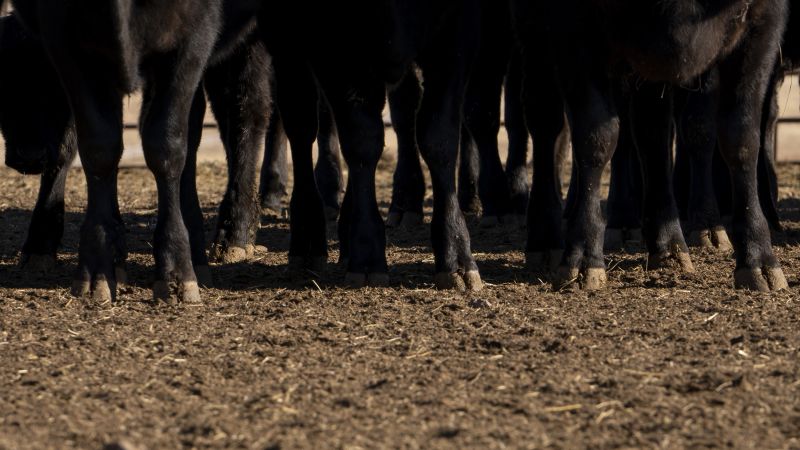Dairy herds in Nevada test positive for newer bird flu strain that’s been linked to severe human infections – CNN

Six dairy herds in Nevada have tested positive for a newer variant of the H5N1 bird flu virus that’s been associated with severe infections in humans, according to the Nevada Department of Agriculture.
Scientists say these infections with a different type of virus mark an inflection point in the nation’s efforts to contain the virus: It may be here to stay.
The strain is not the same one that has been circulating in other dairy herds throughout the United States, a virus called B3.13. The newer version, D1.1, has previously been detected only in birds and in people who had contact with infected birds.
This is the first time it has been found in dairy cattle, meaning these cows caught it from wild birds, instead of another infected herd. This is the second known instance of a type of avian flu being introduced into cattle herds by birds. It suggests that the virus could be seeding itself into cattle through introductions from wild birds, which are ubiquitous.
Related article
Trump administration’s halt of CDC’s weekly scientific report stalls bird flu studies
That could mean the H5N1 infection might become endemic, or continuously circulating, in birds in North America, and that may eventually spell trouble for people, too.
“In my opinion, it is now endemic, and it should be classified as an endemic virus,” said Dr. Louise Moncla, a pathobiologist at the University of Pennsylvania who runs a lab that studies how viruses emerge in human populations and spread.
The US Department of Agriculture classifies H5N1 as a foreign animal disease, meaning an infectious disease in animals that is not currently present in the United States. In an October news briefing, Dr. Eric Deeble, deputy undersecretary for marketing and regulatory programs at the USDA, said agriculture officials were still confident that H5N1 could be eliminated in the national herd.
Experts said repeated infections of cattle by wild birds will make that that possibility more remote.
“It’s much easier to control virus spread when you’re talking about a virus spreading from cow to cow than controlling spread from birds to cows,” said Dr. Scott Hensley, a microbiologist who studies the evolution of flu viruses at the University of Pennsylvania’s Perelman School of Medicine.
This isn’t the first time the US has had to contend with such a destructive bird flu outbreak.
Related article
Is bird flu the next pandemic? What to know after the first H5N1 death in the US
In 2014, highly pathogenic H5N8 bird flu viruses from Europe arrived in North America, resulting in the destruction of more than 50 million commercially farmed birds. This aggressive culling worked. North America remained free from highly pathogenic bird flu viruses for years.
Moncla thinks this go-round with the virus will be a different story, however. She and her team recently posted a preprint study on how the H5N1 virus was introduced in North America in late 2021 and quickly found its way onto farms. By studying the evolution of the virus, they determined that spread into poultry flocks was driven by somewhere between 46 and 113 introductions of the virus from wild to farmed birds. Now, she says, with the virus spreading in so many different species of mammals and birds, it is likely to be here to stay.
Though all six of the recently infected Nevada herds are in the same valley, Dr. J.J. Goicoechea, director of the Nevada Department of Agriculture, said that after conversations with the farmers and with his state veterinarian, they believe the infection was introduced separately at each of the dairies by wild birds.
Goicoechea said there doesn’t seem to be a lot of movement of people or equipment between the dairies, which have been following strict biosecurity protocols. He said the state is working with the US Department of Agriculture on genetic testing to see whether there are changes to the virus that might help them understand its spread.
D1.1 has been associated with two severe infections in people: a teenager in British Columbia who was hospitalized in critical condition last fall but eventually recovered and a senior in Louisiana who died from their infection in January. Farm workers in Washington state have also tested positive for D1.1 after culling infected poultry. Their symptoms were described as milder.
Related article
With bird flu cases rising, certain kinds of pet food may be risky for animals – and people
Scientists are studying the D1.1 strain to try to learn more about its capabilities and how it appears to be spreading so aggressively.
“D1.1 was initially found, I believe, in August of 2024 in the Pacific Flyway. It’s now in all four flyways, and so we know it’s in the environment, but this is the first time it’s been documented that D1.1 has been in a dairy cow,” Goicoechea said.
The affected dairies have provided the Nevada Department of Health and Human Services with contact information for workers who are being monitored for signs of infection, and they are being offered personal protective equipment, Goicoechea said.
To date, no humans have tested positive in connection with the infected herds in Nevada.
Notably, the D1.1 infections in cows do not appear to be more severe than B3.13 infections, Goicoechea said.
“We’re seeing exactly the same clinical signs,” Goicoechea said. Cows lose their appetite, and their milk production drops. Most recover with veterinary care. “It’s very, very similar signs to what we’ve seen for really the last year, since this started in Texas and Kansas,” he said.
Related article
Avian Flu Fast Facts
The newly infected Nevada herds were detected January 31 through a US Department of Agriculture program that is testing milk in large silos across the US.
“Lots of different bulk tanks from different farms can come into one silo. And then they trace it back,” said Dr. Seema Lakdawala, a microbiologist and immunologist at Emory University who has been studying how the H5N1 virus is infecting cows.
Lakdawala says the finding raises critical questions about how dairy cattle are being exposed and whether it’s possible to contain the H5N1 outbreak, which is rapidly spreading among animals and birds, though health officials say most people are still at low risk from the virus.
Since March 2024, H5N1 avian influenza has been detected in 957 herds in 16 states, according to the USDA. There have been 67 infections confirmed in humans in the US, nearly all of them farm workers who had contact with infected animals, according to the CDC. That number is believed to represent a fraction of the true number of human infections, however. A CDC study testing the blood of exposed farmworkers found 7% of them had developed antibodies against the virus, suggested they had previously been infected.
A recent study published in the New England Journal of Medicine on the first 46 documented human infections in the US determined that all had mild symptoms that began with red, inflamed eyes and a fever. None of these first patients who became ill after contact with sick animals was hospitalized.
Researchers don’t know why most human infections with avian flu in the US — which have primarily been with the B3.13 strain — have been mild. One reason may be that H5N1 is clumsy at infecting people. It prefers to latch onto a certain configuration of a sugar called a sialic acid that’s plentiful on the cells of birds. Humans have these kinds of sialic acids too, but they’re relatively rare on cells in the human respiratory tract, which is where flu viruses need to land to make us really ill.
Scientists agree that the more H5N1 spreads, the more likely it is to change in ways that could help it get better at infecting people.
“I would say everybody’s really interested in D1.1 right now, because it seemingly came out of nowhere and then caused two very severe human infections,” Moncla said. “So people are quite worried about it.”
© 2025 Cable News Network. A Warner Bros. Discovery Company. All Rights Reserved. CNN Sans ™ & © 2016 Cable News Network.
Source: https://www.cnn.com/2025/02/05/health/bird-flu-cattle-nevada/index.html





